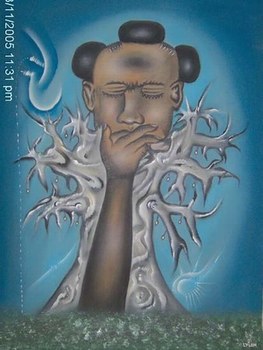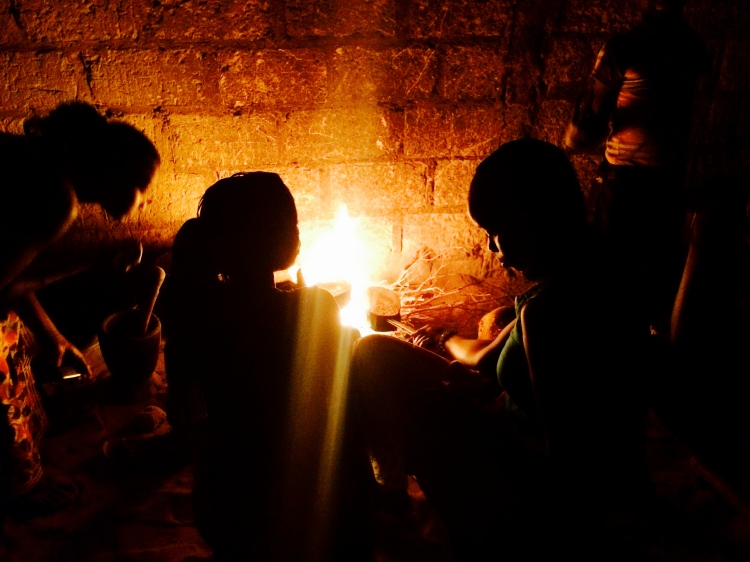“If you want to kill a proud man, supply his everyday need; in the long run you will make him a slave.” -Kocc Barma Fall

A few posts preceding this one, it was mentioned that Kocc Barma Fall – noted Wolof philosopher of the 17th century – was a founding resident and pioneer of my modest (yet mighty) village here in Senegal, Ndiongue Fall. While we don’t boast too much in infrastructure, I did come to find that we do have quite the sizable canary yellow sepulcher dedicated to the man of the hour, about 200 meters north of the village, picturesquely concealed amongst a scattering of Umbrella Thorn Acacia trees. His name carries momentous significance in these parts – not a day goes by that I don’t find myself in the middle of a conversation that mentions sunu maam (our grandparent), wise ol’ Koccy. The man’s life is transcendental, it seems. Nearly five centuries have come to pass since his living days, and even still I was bestowed the name Kumba Kocc Fall upon arrival as a new resident with the utmost reverence and relevance. He’s the big cheese of this bush, and we’re all simply substandard to the infallible wisdom of his legacy.
Naturally, I wanted to pry a bit more into this tidbit of intrigue. Is this tomb open? How hair-raising is it after nightfall? Are there mysterious texts scribbled about within the enclosure, Wolof or Arabic notations of his mind’s rambles? In the practice of self-restraint, I withheld the brimming impulse to tack on my GoPro and carry out a greenhorn attempt at a self-led Blair Witch Project like production. I did, however, set out one afternoon to survey the edifice, only to learn upon return that I had committed a cultural faux pas in not bringing the man some nomz. Excusez-moi? Despite the fact that his organic composition 6 feet under is completely subsumed into the surrounding soil (and has been for, oh I don’t know, 500 years), the Senegalese have done it again: no one goes hungry in this country if they can help it, even the dead. Any time there is a ceremony in the village: baptism, wedding, funeral, religious gathering – it’s customary to delivery our great (great, great..) gramps a hearty bowl of what’s cooking. I decided later to opt for a more feasible, interrogative approach to acquiring some insight on Kocc. Probably would have made his dish too sauf kaane (spicy) anyways..
On a few of the stagnantly brutal afternoons where inertia swoops in, taking a firm, resolved grip upon the village’s populace, I find my time oft spent sprawled upon a woven basin, in the company of our village historians: my host father and our chef de village, village chief. (Cue fortuitous opportunity to pick their grizzled heads on the historical happenings and bygone leaders of the land.) Unremarkably, expectation and reality rarely spill into synonymous streams when intentions are carried into action, and the history lesson didn’t quite pan out as hoped. I chalk this up to equal parts language nascence (You don’t exactly receive complex, thoughtful answers when posing questions like, “Kocc Barma, when was his Birthday?”), as well as the seemingly effortless way in which many a countryman brushes off matters at hand for a later date, in exchange for a good loll in the present. Benin yoon, waay (another time, friend), is used in correspondence as frequently as ceeb (rice) shows up in the lunch bowl. Aka errday. This population of gorgeously deep-toned, glossy skinned men and women also boast an incredible mastery in the art of sidelining – indirect communication is tactfully tucked into greetings, courtship, business, and so forth. A notable example, especially as a Community Health Extension Agent, is the taboo that surrounds speaking aloud about a woman’s pregnancy. She could be bursting at the seems, ready to pop out a ripe one, and yet not a soul will make mention of it in a public setting, making it quite difficult to have a one-on-one conversation about her “action plan” for pre and post natal care should complications arise, what to be supplementing in her diet for adequate nutrition, and suchlike.*
*Examples such as this, shed a shaft of light on how the development of health in Senegal is often compromised by longstanding cultural roots, making it difficult to collect accurate data on health indicators, or even spark particular discussion points on touchier matters such as family planning. This cements just how crucial intentional relationship building in the community setting is in order to understand what’s really going down, as well as appropriately discuss/educate based on the striking needs of the area.
Back to the case in point, I didn’t get a detailed lowdown from pops and his right hand man – though I did come away from those sit downs with a few cups of exceptional attaya, infused with fresh mint and lemongrass – so by no means would I consider the endeavor to be a flop. And so enters Plan C. To keep up solidarity with my fellow Generation Y’s, I resorted to what we do best: I googled the guy. A work meeting had conveniently brought me into Thiés – aka the land of internet and fresh fruit, alhumdulillah. With a bit of incredulity, I toyed around with a few different search engine entries, not expecting to unearth too much, let alone in a language that could comfortably be read at leisure. The results offered the following collection: A French university student’s subjective roast of Kocc Barma’s ideologies, in the form of a measly term paper, a synopsis for a 1992 Senegalese independent film titled Guelwaar whose lead quotes Barma on the reg, a handful of folklike illustrations of the man (he was known to keep his ‘fro under control by sectioning it into four pom-pom tufts), and finally, a YouTube video titled “Histoire de Kocc Barma Fall”. I’m no erudite, but something told me the latter would be my best bet.
After ten minutes of impatiently idling for the bandwidth to catch enough muscle to load the video, what came to follow cast off any lingering agitation and replaced it with full-blown amusement. The figure showcased on the clip playing back at me, a 11:24 segment for a local culture web series with 24,000+ views, was none other than my dear old host dad, Ndongo Fall. Needless to say, tickled is an understatement. My Senegalese father is a YouTube star. He has exceeded the hits that I would ever even hope to fathom to have on this blog by a tenfold, and kicks it on the reg without running water or electricity. I still find myself in constant fits of laughter just appreciating the power of such irony.
Of course, the first thing out of my mouth when I got back to site was an animated blabbering on about how I saw dad on “The Net” (you would have thought he just had a cameo on the History Channel by the way I was excitedly flailing about the yard). True to bossman form, he let out a refined chuckle of acknowledgement, keeping any excess of grand regard at bay. Modest man, man. Ramadan was in full swing that evening, and I had hiked home just in time for ndogo, the meal that breaks the fast, which is customarily tandarma (dates) followed by a portion of bread with a spicy onion/spaghetti sauce slathered on, though the meals vary according to region as well as socio-economic standing within Senegal.** After the call to prayer, my father came back over, (I believe slightly impressed at my inextinguishable stubbornness) and we talked about his filmed interview a bit more in depth. In his words, Kocc was a sergeant at arms for his followers of thought. He promoted the arts, education, and the power of philosophy in combination with one another to best reach his people. Patient and tireless, he is described as “an old man with the spirit of a frolicking child”, who could work fervently with the might of a field worker, and still have the energy for teachings in the evening. He would travel, but always stayed loyal to his village and his roots. He goes on to explain how Kocc instructed the women to be as strong as men, and the men as strong as the women. I could visibly see the gleam of pride in my dad’s eyes as he spoke of his ancestor. Now, I’m sure we should stay mindful of the power of sensationalization in storytelling, but this guy sounds pretty grade A for the time being. I’d certainly yendoo (to spend the day with someone) with the dude.
**The religious makeup of Senegal is composed of 90% Muslim, 7% Christian, and 3% Animist. The country is known for its longstanding tolerance and peaceful coexistence amongst its multifaceted cultural and religious composition. During Ramadan, the customary month of fasting for Muslims, the entire country transforms. Whether you are fasting or not, of the faith or otherwise, there is an exceptionally unique solidarity observed while “in the month”.

Sisters take to roasting coffee beans on open fire on a Ramadan evening in late June, 2015.
Soon after, the moon’s luminous crescent casts a hair of visibility in the yard, and papa fidgets with the radio until the news materializes, a bit muffled. Trying my darndest to follow along with the Frolof (French infused Wolof), I almost didn’t catch my father asking me, “How’s your president doing, John F. Kennedy?” I’m gonna let that one slide; the man’s clearly too sought after in his own local municipal to bother keeping up with contemporaries elsewhere.
And without further adieu, I give you the stylings of Ndongo Fall:
(Also a great chance to get an ear for Wolof)
Oh, you say you didn’t really catch what was said in the video
and would actually be interested in knowing a bit of Kocc Barma’s philosophy?
The four tufts of hair on his head represented these four aphorisms:
Love women, but never lend your confidence to them
The king cannot be kin
The adopted child is never a true son
It is good to have an old man in a village
(Not sure if he was the first man to blurt out that women should not be trusted, but we’ll give him some slack considering there wasn’t too much globalized thought exchange in the 17th century. It should be noted that his maxims are in no way a reflection of my own opinions. Much of his intended preachings are a bit too old-fangled for my taste.)
In this graffiti depiction of Kocc, he is illustrated wearing Gris-Gris around the neck. Gris-Gris a protective token made of leather, red flannel, or chamois is more commonly seen worn by young children to ward off evil.
Humored and hungry,
N.M.M
